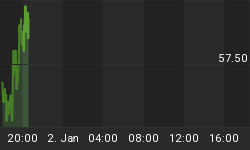The key development last week was the ability of the bond market to bounce from a major support level in spite of the continuing relentless hawkish trash-talk from various Fed-heads. While I had a number of subscribers ask me what it would take to change my positive outlook on the long end of the bond market, these questions further underline the negative bias that still engulfs the bond market. I have considered these questions carefully, and I was able to come up with the following list of items that would damper my optimism toward bonds: (1) wage gains outpacing accepted inflation, (2) the US Dollar index falling precipitously, (3) the Fed suddenly switching from tightening to easing mode (this option might cause a blowoff rally before bonds sold off), (4) Ben - I want to throw money from helicopters to avoid deflation - Bernanke getting elected as the next Fed Chairman. I should also note that the negative impact of item 4 should be delayed. This list is not comprehensive, as other events might pop up that could influence the fixed income landscape. There is also a strong possibility that a number of the above items will occur at the same time or as a chain reaction. Discussing these scenarios in greater detail will follow during the course of the next few weeks. In the meantime, I just wanted to mention that the Bank of Canada raised its overnight rate 25 basis points to 3% and indicated that it remains in tightening mode going forward.
NOTEWORTHY: The economic data was mixed again last week. The PPI inflation report confirmed the trend to higher headline inflation, while the core measure was muted again. Energy - obviously the main culprit for the higher prices - has meanwhile started a corrective phase. This is just anecdotal evidence, but gasoline prices in our neck of the woods have declined approximately 20% from the peak levels at the beginning of September. With lower energy prices and a stronger dollar I believe we have seen the highs in measured inflation in the short run. This dynamic will be a supportive factor for the bond market. Next week's economic data will be sparse again. Highlights in the US include the Durable Goods Report on Thursday and the GDP report along with Consumer Confidence and Personal Consumption data on Friday. The quarterly reporting season will continue to be in full swing. In Canada the CPI report on Tuesday will be the highlight to keep an eye on.
INFLUENCES: The latest Treasury market surveys are still predominantly bearish. While a number of surveys are not near extreme levels any more, bond bears still outnumber bulls by a 2:1 margin. The 'smart money' commercials have marginally decreased their long positions in the 10 year note futures from 142k to 128k this past week. This number has no added value for forecasting bonds at this point. Seasonals are now positive for the bond market. On the technical front, the 10 year Treasury note has managed to hold the 4.5% level and bounced to a lower yield.
RATES: US Long Bond futures closed at 113-23, up a dollar this past week, while the yield on the US 10-year note decreased 10 basis points to 4.38%. The Canada - US 10 year spread was in 9 bps to -35 basis points. This spread has more room to narrow, so traders are advised to remain short Canadian 10 year bonds against a long position in US 10 year bonds. This trade was initiated at pick-up 50 basis points. The belly of the Canadian curve outperformed the wings by 4 basis points last week. Selling Canada 3.25% 12/2006 and Canada 5.75% 6/2033 to buy Canada 5.25% 6/2012 was at pick-up of 16 basis points. I would like to reiterate last week's comment: we are pushing into neutral territory, all you little bond portfolio managers who made oodles of money having been heavily overweight the middle part (a.k.a. the belly) of the yield curve, you should start lightening up on these positions. The recommendation is to take a few chips off the table, but not to completely exit the trade as yet. Assuming an unchanged curve, considering a 3-month time horizon, the total return (including roll-down) for the Canada bond maturing in 2014 is the best value on the curve. In the long end, the Canada 8% bonds maturing on June 1, 2023 continue to be the cheapest issue on a relative basis.
CORPORATES: Canadian Corporate bond spreads were mixed to wider last week. Long TransCanada Pipeline bonds were 1 wider at 115, while long Ontario bonds were also 1 wider at 48. A starter short in TRAPs was recommended at 102 in February 2004. Shorter maturity, quality corporates should be favoured over lower rated issues as I believe corporate spreads will continue to be under pressure. Any credit that is connected with the consumer and discretionary spending should be avoided. We advised to sell 10 year Canadian Bank sub-debt at a spread of 58 bps over the 10 year Canada bond a few weeks ago. This spread closed at 57 basis points on Friday - in 1 basis point on the week. Canadian credit spreads are not only expensive relative to historical averages, but also relative to international spreads.
BOTTOM LINE: The bond market has recovered somewhat after holding the key 4.5% level on the 10 year Treasury Note. The bounce has been less than spectacular. The curve is expected to retain its flattening bias. A trading position was initiated to sell 10 year Canada Bonds to buy 10 year US Treasury Notes. An overweight position in the belly of the curve is still recommended for Canadian accounts, but to a less extent than over the past 2 years. Ongoing underweight exposure for the corporate sector is advised.
















